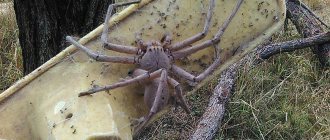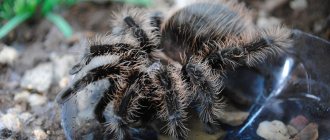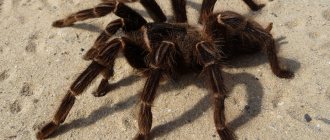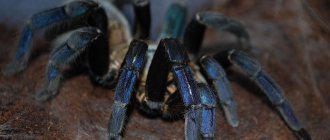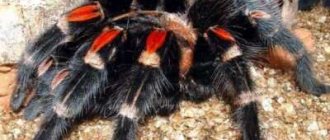Spiders 08/07/202025686 views
Tarantula spiders are increasingly winning the hearts of people and are overtaking fish in popularity as pets. In total, there are more than seven hundred species and this list is updated every year, but there are species that have gained the most popularity in keeping. Such spiders have beautiful colors, interesting behavior and great fertility, and as a result have become widespread among those who like to keep exotic animals at home. So, let's start our top:
Reproduction
The sex of a tarantula spider is easy to determine if you follow the recommendations of experts. Young spiders begin to molt after about a month. After molting, the skin is taken and carefully examined. In the posterior region of females there is a depression, and in males there are something like two tubercles. If the individuals are adults, then the sex can be determined by appearance. Males have slightly slimmer legs and are taller, while the body is significantly smaller in size than the female.
After mating, the eggs develop inside the female for 2 months. During this period, she must form a special cocoon. At one time, she can lay up to 500 eggs, while about 50 spiders remain alive. In order for the juveniles to actively develop, the cocoon is moved to a separate terrarium, thereby creating certain temperature conditions.
For the first month, baby spiders do not eat anything, until the first molt. Until this moment, they can be together, after which they are separated one by one. A female tarantula spider molts up to 12 times during her entire life. Males stop moulting immediately after puberty.
Reproduction
Experts tell us how to determine the sex of a tarantula spider. After about a month, the young generation molts. You need to remove the skin. Examine it carefully. Females have a depression on the back side, males have two tubercles. In mature individuals, sex is determined by appearance. Males are always taller, slimmer, and have longer legs. But the body itself is significantly smaller in size than females.
After mating, the eggs inside the female develop for about 2 months. During this time she weaves a large cocoon. Lays up to 500 eggs at a time. Approximately 50 remain alive. To enable the cubs to fully develop, the cocoon is moved to a separate terrarium and the necessary temperature conditions are created.
After birth, the cubs do not eat anything for about a month. During this time they can be kept together. After the first molt, they are seated one at a time. Over the course of their entire lives, female tarantulas molt 12 times. In males, this process stops after puberty - after 5 years of life.
Kinds
The tarantula family includes many species, representatives of which differ in size, color, habitat, lifestyle and habits. Some of the more interesting varieties:
- The goliath tarantula is a spider that is considered the largest in the family and the second largest of all existing spiders. Theraphosa blondi (lat. Theraphosa blondi) lives in South America, preferring marshy areas. The color is beige, brown, sometimes with a red tint.
- The black and white Brazilian tarantula is slightly smaller than the goliath, its size can reach 23 cm. These arthropods live under the roots of trees or among stones. They are characterized by aggression and unpredictable behavior.
- Brachypelma Smith (lat. Brachypelma smithi). This species is also called the Mexican tarantula, as the arthropods are primarily found in Mexico. They can also be found in South America and Australia. The Pododor spider grows up to 17 cm. The color is dark brown or black, with areas of red or orange on the legs. Due to the specific coloring of this spider, it is called the red-knee tarantula.
- The metallic (blue) tarantula is found in the southern regions of India. The tree spider grows up to 20 - 21 cm and stands out among its relatives with its bright color. The body and legs of the spider are bright blue with a metallic tint.
Tarantula spider at home
More and more people, when choosing a pet, prefer exotic animals. Keeping tarantulas indoors is an increasingly popular hobby.
These arthropods are particularly beautiful, unpretentious, easy to care for and interesting to watch.
A terrarium is best for housing spiders, and experts recommend keeping adults alone to avoid cannibalism.
The size must be selected according to the size of the animal. Containers that are too tight and too capacious are undesirable. An arthropod must have a shelter in a terrarium, otherwise it will constantly experience anxiety and become aggressive.
Since tarantulas easily move along vertical surfaces, the container in which the spider lives must have a lid, otherwise the animal will crawl out.
For food, it is best to choose those foods that are available to spiders in their natural habitat. Most often, the diet of tarantulas includes cockroaches, mealworms, and crickets.
Spiders cannot be trained or trained in any way. It is also not recommended to pick them up, since it is difficult to predict the reaction of even the calmest animal.
A frightened spider can bite at any moment. In addition, there is a high probability of developing allergies due to contact with the stinging hairs covering the body of the arthropod.
Danger to humans
All tarantula spiders are poisonous. If they talk about a safe animal, this means poison of low toxicity. There are no officially registered cases of human death from a bite. However, there is information that cats have died from pets. Often the bite occurs dry - without injecting poison. Then only a small hematoma remains at the site of the attack.
An allergic reaction to a toxic substance depends on the state of the immune system and age. Spider bites are potentially dangerous for children, people prone to allergic reactions, and the elderly. Possible consequences are local skin allergies, breathing difficulties, muscle spasms, vomiting, abdominal pain, weakness, dizziness.
In natural conditions, spiders shed poisonous fibers when there is a threat to their own lives, and weave them into the web when forming a cocoon with eggs or a nest. In the terrarium, the tarantula sheds its lint due to stress. Inhaling them leads to the development of allergies - rhinitis, cough, shortness of breath, difficulty breathing, lacrimation, etc.
At home, tarantulas are kept in terrariums and fed with insects. It is impossible to train or accustom spiders to anything.
Natural enemies
Despite their poisonous nature, tarantula spiders quite often become prey for many other animals. Predatory species of centipedes, including Scolopendra gigantea, are quite capable of coping not only with the largest tarantulas, which include Theraphosa blondi, but even with many species of not very large snakes.
Another dangerous predator for the spider is a representative of the genus Ethmostigmus, which inhabits Australia and is one of the natural enemies of the tarantula.
Natural enemies of tarantulas in the wild include fairly large spiders from the genus Lycosidae and Latrodectus hasselti.
Some vertebrates destroy arthropods, including the largest Australian frog, Litoria infrafrenata, or the white-lipped tree frog and the aga toad Bufo marinus. The body of tarantulas is often parasitized by small dipterous insects belonging to the genus Megaselia and the family Phoridae and hawk wasps. The larvae grow and develop inside the spider, causing its death.
A natural competitor for the giant Goliath tarantula is the spider Heteroroda maxima, found in Laos and superior to the Goliath solely in the span of its legs.
Lifestyle and habitat
The tarantula spider lives on all continents except Antarctica. These are rather heat-loving arthropods, so they are mainly found in countries with warm climates.
The habitat largely depends on the type of spider. So, some tarantulas live in tropical rainforests, while others prefer to settle in the desert, where the climate is dry and hot.
Spiders also differ in their living conditions:
- digging - usually occupy empty holes of rodents and other small animals;
- arboreal: settlement in the dense crowns of trees or shrubs;
- ground: organize shelter on the surface of the earth.
Interestingly, with age, the lifestyle, habitat and habits of tarantulas can change. For example, a larva that developed in a hole, becoming an adult spider, prefers to live on the surface.
Tarantula spiders lead a solitary and sedentary lifestyle. They spend most of their time in their shelter (being well-fed, they do not leave it for several months).

